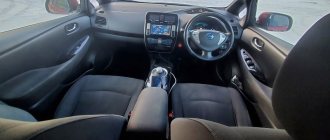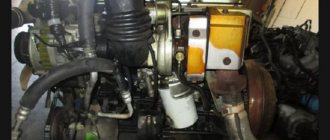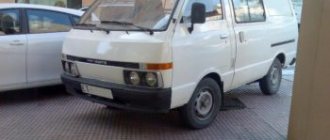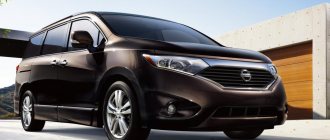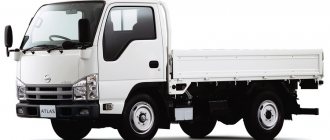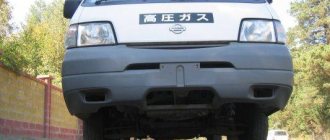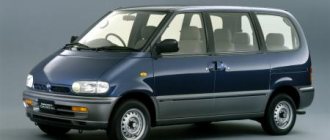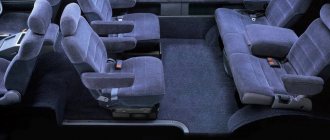Nissan Vanette (other names: Nissan Van, Sunny-Vanette) is a popular cabover minivan produced by a Japanese company since 1978. The model was available in various body styles: small truck, van and minibus with a capacity of up to 8 passengers. In Europe, some modifications of the car were sold under the name Nissan Serena.
The production of Nissan Vanette continued for a long time at enterprises located in Spain and Japan. Production of the minivan ended in 2011. It was replaced in the Nissan lineup by the NV200. However, sales of the Vanette model continue in some countries.
Nissan Vanette is unpretentious and reliable. The car is ideal for traveling in a large group or with family.
Model history and purpose
1st generation
Nissan first introduced the Vanette minivan back in 1978.
The model replaced the Nissan Cherry Cab (Sunny Cab C20). Initially, 3 modifications of the car were available: a 9-seater minibus (Coach version), a truck and a van with the ability to transport passengers. At the same time, it was possible to drive a Nissan Vanetta with a category “B” driver’s license. The car immediately became very popular in Japan and Europe. The very idea of creating such a model was not new; by that time, many brands had expanded their line with similar machines. The Nissan Vanette has a classic appearance for this class: large round headlights, slightly awkward body lines and a standard bumper. A year later, the Japanese brand introduced a version with an extended wheelbase. Later, a luxury version of the model with a swivel driver's seat appeared. This solution turned out to be innovative. The evolution of the Nissan Vanette continued. In 1982, further design changes took place: the air conditioning system was improved, front disc brakes and a new instrument panel appeared.
2nd generation
In 1986, the second generation of the minivan premiered. External changes were immediately noticeable. The angular contours of the body have been preserved, but the car has become more proportional and interesting. A line of engines, consisting of injection and carburetor engines with a power of 88-120 hp. replenished with a 2-liter turbodiesel (79 hp). Versions with a 4-speed automatic transmission also appeared. Certain improvements have also been made in the design. The quality of finish has improved, and the model has become easier to operate.
3rd generation
In 1994, the Japanese concern introduced the third generation of the Nissan Vanette. The car remained rear-wheel drive, but the layout became more modern - single-volume. The model was made in the European style, but it retained the outlines of its predecessor. The body received a half-hood layout (the front axle and engine were moved forward of the cabin under the first row of seats). This solution made it possible to make the weight distribution ideal. The vehicle's carrying capacity has also increased slightly - to 535-740 kg, useful volume - to 4.8 cubic meters. Changes also occurred in the motor range. The minivan was offered with a 1.6-liter unit (98 hp), a new 2-liter engine (126 hp) and a 2-liter CD20T diesel engine (66 hp). Improved power plants have made the Nissan Vanette more economical and dynamic. In 1995, a 2.3-liter diesel engine (135 hp) was added to the engine line. The engines were equipped with a 5-speed manual transmission. An optionally modified “automatic” was offered. In the same year, the production of new modifications Vanette Cargo and Vanette Combi began.
4th generation
In 1999, the fourth generation Nissan Vanette was shown to the public.
Among the main features of the new product are a simple interior trim, a rounded body design, interesting headlights, a bumper that protrudes forward and an expanded range of engines. The car has remained a reliable and practical vehicle with many different modifications. In Russia, the model was not as popular as in the West. Nissan Vanette has an almost ideal interior layout, which was developed specifically for transporting cargo and long trips. Despite many modifications, the most popular were passenger and semi-truck models. They are still actively exploited today.
Specifications
Overall dimensions of the basic version:
- length – 4285 mm;
- width – 1690 mm;
- height – 1985 mm;
- wheelbase – 2200 mm;
- front track – 1460 mm;
- rear track – 1465 mm;
- ground clearance - 170 mm;
- minimum turning radius – 5000 m.
The body of the Nissan Vanette can accommodate up to 4.8 cubic meters of cargo. In the Combi version, the passenger capacity is 5-8 people. The carrying capacity of some versions reaches 750 kg, the total weight is 2050 kg.
The minivan stands out for its low fuel consumption. Consumption in the extra-urban cycle is 6.25 l/100 km, in the urban cycle – 10.2 l/100 km. The fuel tank holds up to 53 liters of fuel.
Characteristics of the wheels used: 175/R14-6PRLT.
Nissan Vanette / Nissan Vanette
Vanette: parameters, tests (test drive, crash test), reviews, car dealerships, photos, videos, news.
Nissan Vanette
- beginning of production in 1995. Among the existing basic colors of Vanette, you can easily find one that suits you, but most likely you can choose it to order.
We most likely do not have all the configurations of this Nissan Vanette model, among which there are various Vanette assembly options: the gearbox can be automatic or manual, leather trim or wood inserts, wheels and other additional elements of the Vanette body, which will certainly be reflected in the price Vanette. The technical characteristics are good, but do not forget about the safety of the Vanette or the engine size, which will then make itself felt in terms of operating costs in the future, as well as Vanette repairs and maintenance with a warranty period. Since the purchase is made not for several months, but for several years, therefore, consider for yourself what you will do in the summer and winter, what trips to make in the Vanette
. The table below shows a comparison of several Vanette configurations, the parameters include: what are the overall dimensions of the Vanette, what is the fuel consumption in the city, highway or mixed, engine size, maximum speed and acceleration time to 100 km/h, curb or gross weight of the Vanette, wheelbase, front and rear wheel tracks, transmission type (gearbox/gearbox), what kind of drive, tire size, how much power or torque and what price. In addition to all the numbers, you can read reviews of car owners about Vanette, watch videos or news, tests (test drive, crash test).
Engine
The power plant in the Nissan Vanette has a longitudinal arrangement. The fourth generation of the car was equipped with a 1.8-liter gasoline unit or a 2.2-liter diesel engine. The latter was replaced in 2003 with a more powerful 2-liter turbodiesel engine.
Characteristics of a gasoline engine:
- working volume – 1.8 l;
- rated power – 66 (90) kW (hp);
- maximum torque – 135 Nm;
- number of cylinders – 4;
- the type of fuel used is gasoline AI-92, AI-95.
Diesel engine characteristics:
- working volume – 2 l;
- rated power – 63 (86) kW (hp);
- maximum torque – 178 Nm.
Fuel consumption
Generation 1 (1978-1988)
Gasoline engines
- 1.2, 70 l. p., manual/automatic, rear
- 1.4, 80 l. p., manual/automatic, rear
- 2.0, 90 l. p., manual/automatic, rear
Diesels
- 2.0, 60 l. p., manual/automatic, rear.
Generation 2 (1985-1994)
Gasoline engines:
- 1.6, 100 l. p., manual/automatic, rear
- 2.0, 90 l. p., automatic/mechanical, full
- 2.0, 130 l. p., automatic, rear/full
- 2.4, 105 l. p., manual/automatic, rear/full.
Diesels
- 2.0, 76 l. p., manual, rear
- 2.0, 91 l. p., manual/automatic, rear/full
- 2.0, 67 l. p., manual/automatic, rear/full
Generation 3 (1994-1999)
Diesels:
- 2.0, 67 l. p., manual, full/rear, consumption – 8.5/7.1 l per 100 km
- 2.3, 75 l. p., manual, rear/full, consumption – 12.7/7.9 l per 100 km
Generation 4 (since 1999)
Gasoline engines:
- 1.8, 95 l. p., manual/automatic, full/rear
- 1.8, 102 l. p., manual/automatic, full
Diesels:
- 2.0, 86 l. p., automatic/mechanical, full/rear
- 2.2, 79 l. p., automatic/mechanical, full/rear.
Device
Nissan Vanette belongs to the category of trucks and has a design characteristic of this class. The model is available in the following versions: chassis with cab (Truck), van (Practic and Van), variation with an on-board platform and a small minibus (Combi) with a capacity of 2 to 8 people. The car is popular in families where one of the members has a category B driver's license.
The latest generation of Nissan Vanette is characterized by rounded shapes and a frame design. This arrangement makes the car very stable and durable. The machine confidently transports loads in excess of the declared weight. At the same time, the chassis allows the installation of various body types, which increases the capabilities of the model.
The Nissan Vanetta uses a spring or spring variation as a suspension. The latest versions usually use spring suspension with 2 arms in the front. The drive axle is located at the rear. The basic version is rear-wheel drive, but all-wheel drive modifications are also available. It's quite easy to distinguish them. If the car has rear-wheel drive, then the VN index appears in the name. All-wheel drive is designated in the markings by the letters MN.
The Nissan Vanette's braking system is standard. The latest generations use disc brakes, while earlier versions use drum brakes. The hand brake is of a mechanical type.
The main one for the car is a manual transmission (4- or 5-speed). An automatic transmission is available as an option.
The interior of the Nissan Vanette is very thoughtfully designed. A fairly simple dashboard and a comfortable steering wheel with various adjustments ensure comfortable driving. The driver's seat is adjustable in several directions. All seats are upholstered in velor and have armrests. An additional advantage is the transformable interior, which allows you to free up space or adjust the space for specific purposes.
Among the main disadvantages of the model are:
- slight noise when changing gears;
- weak cardan shaft crosspieces (this problem is typical for all rear-wheel drive cars).
Technical characteristics of the Nissan Vanette Cargo 2.3D (HC23)
- 09.08.2009
KiberVumen_09082009
Author's rating
Objectivity
I don’t know of such problems as heating even in our northern conditions! But for racing it’s definitely not an automatic or a hatchback. Friends are pleased with the amount of space for this class of car. I don’t really like the revs at 90 km 3000 I have to switch to gear 5 and still the engine can be heard before the car was quieter. By the way, I didn’t set the alarm and I’m glad, my dear one does an excellent job, the battery starts even in 45 below zero, the service department has no reason to blame it on anyone.
more details
- 15.12.2008
Michael
Author's rating
Objectivity
For a golf car, the car has a very spacious interior. Getting in and out is easy. Visibility, including to the rear, is beyond praise; there are no problems when parking. It’s a bit cramped for three people in the back, but it’s quite comfortable for two people. The trunk in the hatchback is small, but it is possible to move the rear seats forward. This allows you to increase the volume of the cargo compartment. The seat back folds, but a flat platform is not formed, which makes it somewhat difficult to transport long cargo in the car, as well as loading and unloading it. In the basic configuration, the car is well...
more details
- 18.03.2009
Nesterenko Leonid
Author's rating
Objectivity
I bought it in Khabarovsk, after 10 years of operation in the Russian Federation Design: nuance: my body is not on the list: I have a CY-31. It's a matter of taste, but I like this body more than the more recent ones. Optics: No complaints. Quality of body covering: Still excellent Design: Dark brown velor, wood-look inserts - still a luxury car... Ergonomics: Excellent Practicality of finishing materials: Japanese quality Capacity: Four - excellent. Five of us - not very much anymore..
more details
www.autonet.ru
Reviews
- Artem Vitalievich: purchased a 1992 Nissan Vanneta in September 2012. Despite its advanced age, the car looked very good. I decided to take this particular model because I had heard about Japanese quality. Externally, the car was not very pleasing - an angular, inconspicuous minivan. However, inside the Nissan Vanneta was spacious and allowed to transport a lot of things. I took the version with a 2-liter diesel unit with 80 horsepower. With this engine, the car drags everything. Large overload is not a problem for her. The car's speed is not very good. I accelerated it to a maximum of 110 km/h, but that was quite enough for me. The car itself is nimble and agile, it is perfect for urban conditions. Consumption on the highway is about 8 liters, in the city - just over 10 liters. It took me a long time to get used to the absence of a hood, but driving with this arrangement turned out to be even easier. There were no whims during 4 years of work. Naturally, we had to periodically change consumables and inspect the car (it’s quite old). Among the shortcomings, I note the simple interior trim (cheap materials), poor sound insulation and a noisy unit.
- Maxim, Vladivostok: bought a Nissan Vanneta in 2012. At that time the car was 2 years old. The model was a gable one with a manual gearbox and an R2 engine. The diesel 4-cylinder unit works quite well, but the electronic brains of the fuel injection pump soon began to cause problems. It sometimes took up to 6 minutes to start. As a result, we had to replace the element with a standard mechanical injection pump. After that everything became fine. In general, repairing a Nissan Vanneta often becomes a big problem. So, it took me about an hour to change a burnt out light bulb. Another disadvantage was the weak suspension. After 3 years of work I had to change it. The engine is very demanding on fuel, so it is better to fill the car with good diesel fuel. Otherwise, the Nissan Vanneta is a typical Japanese car, combining high reliability and performance.
Owner reviews
Reviews from vehicle owners agree that the car is very practical to use and economical in repair work and vehicle maintenance. Multifunctionality of models. It can be used for transporting oversized cargo, which has become an indispensable assistant for many people living in rural areas, gardeners and gardeners. Workers of construction companies and companies involved in cargo transportation.
For a large family, how convenient it is when the whole family or a number of friends can fit in the car. Many people use it as an opportunity to go fishing, hunting, or go out into nature without fear of getting stuck or not being able to get through. The spaciousness and comfort of the body and the arrangement of seats were noted, which allows you to travel long distances. Excellent qualities in the behavior of the car in various road conditions on city roads, highways, and small settlements were noted. Despite its dimensions, it is quite nimble and maneuverable for the city. And many other positive reviews.
The disadvantages that were mentioned by people using this car are overheating at high speed, provided the vehicle is overloaded.
But it is worth noting that this most likely applies to all transport mechanisms, subject to permissible overload. Nissan Vanetta is equipped with reliable engines that are simple in design characteristics and performance. From the very beginning of the release of this model, it gained wide popularity and is still in great demand as a reliable machine for various purposes and needs.
Citroen Jumper van specifications.
Views: 8,295
Price of new and used Nissan Vanette
It is currently not possible to buy a new Nissan Vanneta, since production of the car has ended. Used models are a good option because they allow you to get a high-quality minivan at an affordable price. These cars are most popular in the eastern part of Russia and Siberia.
Cost of used Nissan Vanneta cars:
- 1986-1988 – 50,000-86,000 rubles;
- 1993-1995 – 120,000-180,000 rubles;
- 2000-2002 – 220,000-290,000 rubles;
- 2007-2009 – 490,000-610,000 rubles.
